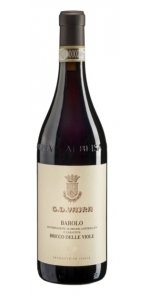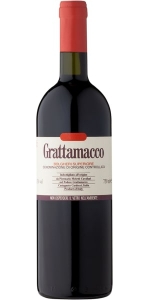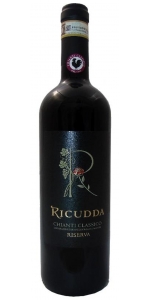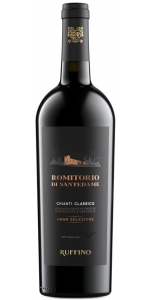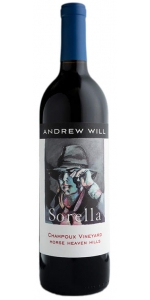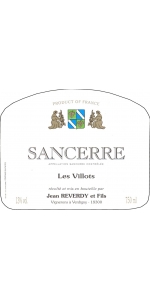Villa Monti Chianti Superiore DOCG Organic 2019
| Country: | Italy |
| Regions: | Tuscany Chianti |
| Winery: | Coeli Aula |
| Grape Type: | Sangiovese |
| Vintage: | 2019 |
| Bottle Size: | 750 ml |
G.D. Vajra Bricco Delle Viole Barolo is made from 100 percent Nebbiolo.
The Barolo Bricco delle Viole shows the signature verticality of its vineyard. The wine is beautifully layered and - while restrained as it’s always the case in the youth of Bricco delle Viole - it also shows a complexity of layers with purple flowers, sweet spices and mineral tones. The palate is noble, with a refined acid spine and profound tannins that promise a long aging potential.
Among the historical vineyards of Barolo, Bricco delle Viole is the highest and the closest to the Alps. It rises from 400 to 480 meters above sea level, on the Western ridge of the village. Its name, “Hill of Violets”, originates from the flowers that blossom early here due to the perfect south exposure. Up above the fogs, Bricco delle Viole enjoys the earliest sunrise and the last sunset every day. Thanks to its vines dating back to 1949 and -now- 1931, a dramatic diuturnal temperature range and this pure light, Bricco delle Viole generates a sophisticated and profound Barolo DOCG of bright aromatics, chiseled tannins and subtle minerality. 2018 is a vintage that shows many nuances of Bricco delle Viole: beyond the signature verticality of this site, the wine offers high tones laced with mineral nuances and plenty of energy and youth.
Review:
A juicy Barolo, with vibrant acidity and a fluid profile that exudes cherry, raspberry, mown hay, mineral and eucalyptus aromas and flavors. Tight yet long, with excellent potential.
#26 Wine Spectator Top 100 of 2023
The last wine poured at my tasting at the winery is the G.D. Vajra 2019 Barolo Bricco delle Viole. With its high vantage point in the hills west of Barolo, Bricco delle Viole is a world apart in terms of soils (with Sant'Agata marl and fossils) and even harvest times. Slow and careful ripening like the kind that characterizes fruit in 2019 renders a very delicate and ethereal expression with floral tones, wild mint and licorice. This organic wine is solid in build and structure. Indeed, Isidoro Vaira remarks that Nebbiolo tannins have changed since the 1970s and 1980s.
-Wine Advocate 97+ Points
Jeweled in appearance, the 2019 Barolo Bricco Delle Viole may be the best wine I have tried yet from Vajra. Its gorgeous and alluring perfume of fresh roses is followed by a Burgundian, elegant red with incredible length and no harsh edges, fine and present tannins, and beautiful, graceful concentration. It is drinking well now, and I will be trying to get my hands on as much of this as possible. Drink 2025-2045.
-Jeb Dunnuck 97 Points
All older vintage wines have been purchased from a single collectors cellar. Pictures can be requested before shipment.
Podere Grattamacco Bolgheri Superiore is made from 60% Cabernet Sauvignon, 20% Merlot, 15% Sangiovese.
#12 Wine Spectator Top 100 of 2022
The olfactory impact is of considerable aromatic intensity: it expands with notes of small, fully ripe red fruits, accompanied by clear balsamic and Mediterranean hints. In progression, typical mineral notes develop. The gustatory impact is austere, of remarkable freshness and of large volume. It develops in a balanced fusion between the broad minerality and the fine and enveloping tannins. Everything is found in the long final persistence that foreshadows a long life ahead.
Goes well with game, as e.g. local preparations of wild boar, roast, braised and stewed red meats, and medium aged cheese.
Review:
Dense and smooth, featuring black cherry, blackberry, plum, iron, licorice and menthol aromas and flavors. Fresh and featuring a spine of tannins, this finishes on the compact side for now. Shows balance, so be patient. Cabernet Sauvignon, Merlot and Sangiovese. Best from 2025.
-Wine Spectator 97 Points
The 2019 Bolgheri Superiore Grattamacco (a blend of 65% Cabernet Sauvignon, 20% Merlot and 15% Sangiovese) is a real beauty and shows very nicely today based on advancing vine age alone. Cabernet Sauvignon and Syrah vines show great results after seven years, whereas Merlot and Sangiovese vines need a few more years before they start to show that extra degree of complexity, the winemaking team tells me. This is a complete and beautifully balanced wine that shows soft extraction and especially sweet tannins. It fermented in truncated conical oak vats and finished in barrique for 18 months.
-Wine Advocate 97 Points
Ricudda Chianti Classico Riserva 100% Sangiovese.
Deep ruby red color.
The wine shows an intense and persistent bouquet, with notes of berries and spices such as licorice and black pepper. Well-harmonized hints of oak.
In the mouth, it is well structured and balanced, complex, persistent with notes of red fruits and spices such as black pepper and licorice.
Pair with grilled red meats, steak, game of hair and feather, stewed and roasted, aged cheeses hard like pecorino.
Review:
"A very fine riserva with black-cherry, walnut with some cedar aromas and flavors. It’s medium-bodied with lovely tension and a fresh finish. Racy and refined. From organically grown grapes. Drink or hold."
- James Suckling (June 2022), 93 pts
Ruffino Romitorio di Santedame Chianti Classico Gran Selezione DOCG is made from 90% Sangiovese, 10% Colorino.
Romitorio di Santedame, a limited-production Gran Selezione from Castellina in Chianti, pays homage to a rich history while embracing a bright future. It originates from a single vineyard within the Chianti Classico's "golden basin" (Conca d'Oro) and is crafted from an exclusive blend of Sangiovese and Colorino. The latter is a native Tuscan grape variety that was nearly extinct but has experienced a revival through dedicated research and promotion efforts.
Fruity aromas typical of Sangiovese, including black cherry and ripe plum, with violet and complex chocolate and black pepper notes. The palate offers sweet tobacco and balsamic hints, while its balanced structure with refined tannins and lively acidity makes it suitable for extended aging.
Review:
You feel the oak here, suggesting vanilla and clove character, but it’s very well complemented by the dark fruit, ranging from blackberries to mulberries to dark cherries. Full-bodied, dense and decadent with a regal structure and muscular tannin backbone. The acidity cuts nicely through on the long finish and provides freshness. Drink from 2024.
-James Suckling 94 Points
Andrew Will Winery Sorella 2019 is made from 80% Cabernet Sauvignon, 8% Merlot, 8% Cabernet Franc, 4% Petite Verdot.
Sorella means sister in Italian and was named after Chris Camarda late sister Jane Camarda. This first vintage was from 1994. This wine is made from 100% Champoux Vineyard fruit and represents the nature of the vineyard by highlighting the Cabernet Sauvignon, which is considered some of the best in Washington State. The picture on the label is a portrait of Annie Camarda (Chris’s late wife).
Review:
Flirting with triple digits, and perhaps the best Sorella yet, the 2019 Sorella explodes from the glass with a fantastic mineral essence that sways between dark red fruit tones, oak essence and freshly opened flowers. Medium to full-bodied, the wine is impeccably balanced with a silky-smooth mid-palate that bestows a stunningly beautiful wine with gobs of complexity and a ripe frame of glossy black raspberry and blackberry fruit tones. Unwinding across the finish, the wine unpacks gorgeous layers that seduce me for a second, third and fourth sip and finally begs me to finish the glass. Buy this ASAP!
-Wine Advocate 99 Points
Villa Monti Chianti Superiore DOCG Organic is made from 90% Sangiovese, 5% Canaiolo and 5% Colorino.
Ruby red color, with delicious fruity and floral aromas, with a pleasant structure and tannic density, leading to a balanced and persistent finish.
The grapes are coming from Le Tire, Paradiso La Fonte parcels with good sun exposure that gives the wine a lot of roundness and juiciness.
Red meat, Game, Cheese.
Review:
"This certified organic red is stored in cement tanks after it is aged for seven months. We found roses and strawberries on the nose. The powdered rose petal mouthfeel and sweet, ripe red berries were just the start of an exquisite experience. Soft tannins and a delicate acidity keep a freshness on the palate. A denseness comes in mid-way, adding a layer of chocolate cake and violets."
- Tasting Panel (November 2021), 93 pts
As early as the 9th century, there are testimonies regarding the parish church of Santa Maria a Coeli Aula, around which the Cadolingi Counts and the Badia Fiorentina owned possessions. Agriculture was vital for the families who lived in the area, and thus, over the years, wine and olive production have developed.
Tenuta Coeli Auli was developed within the parish grounds. It is located in the hills of Montespertoli, just outside of Florence. Giuseppe Barni purchased the Monti farm in 1949, building the wine business by planting vines, emphasizing vineyard care and increasing production. Today the estate is run by the family’s fourth generation, who maintains the same goals as their ancestors – care for the vineyards in full respect of nature. They began converting all of their production to organic farming in 2015, and today they are a fully organic winery.
Tenuta Coeli Auli has 103 acres (42 hectares) of vines & an annual production of 9,500 cases.
Reverdy Jean Sancerre Rose is made from 100 percent Pinot Noir.
Color: Pale salmon pink color
Nose: delicate aromas of roses and orange blossom that will transform into gooseberry and peach blossoms as the temperature in the glass rises.
Mouth: The palate is crisp, lean and elegant, but the flavors are quite persistent with cherry, blackcurrant,apricot and red currant aromas.
According to the Sancerre AOC regulation, maximum yield authorized for the rosé is 55 hl/ha.
Pairs well with poultry and spicy food.
Review:
"Vivid orange-pink. Fresh strawberry, tangerine and floral scents are sharpened by a frisson of chalky minerality. Clean and racy on the palate, showing fine clarity to the red berry and citrus fruit flavors. Finishes minerally and dry, showing energetic lift and strong, mineral- and floral-driven persistence. - Josh Raynolds"
- Antonio Galloni's Vinous (June 2021), 91 pts
- back
All older vintage wines have been purchased from a single collectors cellar. Pictures can be requested before shipment.
Bernardins Muscat Beaumes Venise VDN 100% Muscat petits grains (75% Blanc, 25% Red)
Copper/rose hue and ripe soft aromas of orange, spice and flowers. The wine is full bodied with the texture of silk and flavors of orange custard, white peach, pear, apricot, toffee and orange peel.
The vineyards and their terroir are the essence of our wines. This is where everything starts and where we focus our efforts throughout the year. You can’t make great wine without great grapes.
The viticulture is essentially done by hand. Five people work full-time in the vineyards. They are supplemented by seasonal employees who work during bunch thinning and the harvest in order to bring out the very best in our vines. Working by hand and the attention each vine gets are fundamental. Pruning, de-budding, trellising, leaf removal and picking are thus carried out by hand with the utmost care.
We prepare the soil by using good old-fashioned ploughing. Organic compost is made from grape marc (the discarded stalks and skins).
As a way of protecting the plants, we only use phytosanitary products when necessary and within strict guidelines by staggering the treatments appropriately, to minimize the amount of chemicals used. We prefer to use as much as possible manual and organic techniques . Leaving natural grass cover, removing buds and leaves from the vines, preserving biodiversity around the vineyard: olive, almond and cypress trees, wild rosemary and capers.
In the spirit of respecting traditional techniques and the best elements of modern technology, cellar manager Andrew Hall and his winemaker son Romain Hall take family traditions very seriously.
When making our wines, the Muscat de Beaumes de Venise plays a central role and requires great care. After picking the grapes by hand, we press them straightaway to ferment the juice without skins. We don’t add any yeasts and keep the alcoholic fermentation in check by temperature control. Vin Doux Naturel winemaking involves stopping fermentation to preserve the grapes’ natural sweetness. During vinification, we watch the vats day and night and add the fortifying spirit just at the right moment. At this stage, the wine’s final balance is at stake. The wine is then aged in stainless steel tanks for 6 months before bottling.
Review:
"Butterscotch and apricot jam aromas. A lighter vintage of this cuvée, but very fresh and drinkable, and the best Muscat of the vintage by far. 110g/L residual sugar. In conversion to organic. - Matt WALLS"
-Decanter (November 2024), 91 pts



